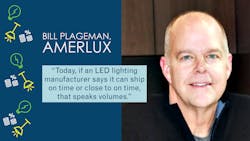High performance, superior controllability, and simplified installation used to be part of the buzzwords needed to close a sale. Phrases such as “beautifully designed aesthetics” and “exceptional value” wouldn’t hurt, either. Certainly, all five of these elements are must-haves as LED lighting manufacturers continue to look for ways to drive revenue. But they’re no longer what distributors and customers need to hear first.
What is the magic phrase, then? — “Shipping now.”
It’s the hard-to-find offering that now beats all, the new way to delight customers. Today, if an LED lighting manufacturer says it can ship on time or close to on time, that speaks volumes. That company is making a bold promise very few manufacturers can keep.
Extensive delays and longer lead times are rampant across the industry, thanks to global vulnerabilities and macroeconomic shifts, including escalating shipping costs, higher material expenses, raw material deficiencies, and component shortages.
The good news is there are signs that distributors, lighting designers, and end users can look for in LED lighting manufacturers to help avert supply chain and production disruptions without compromising quality or budget.
1. They assemble products domestically.
To help avert supply-chain shipping snarls, work with a manufacturer that designs and assembles all its fixtures domestically. That doesn’t mean the manufacturer brings in and stocks the finished product, nor does that mean it assembles products onsite before tossing them into inventory.
Instead, it indicates the manufacturer has a tremendous amount of physical space on hand to store raw materials. LED lighting manufacturers are incredibly flexible when they stockpile raw materials, not finished product.
Consider what many lighting manufacturers have regretfully done during this latest supply-chain squeeze: They committed a significant amount of material into a finished product, compromising their flexibility for incoming orders. The best lighting manufacturers are a step ahead and work differently. They have ample amounts of free raw materials to integrate into whatever product is ordered on the spot quickly.
2. They ensure quality control.
Manufacturers that produce and assemble their product lines under one roof guarantee another critical ingredient — quality control.
Having all operations under one roof ensures the quality of the product, its production, shipping, and job sites. Similarly, co-located operations guarantee that the light fixture performs the way its spec sheet promised, and that quality is maintained throughout the product’s lifetime.
3. They stay in close contact with vendors.
Lighting manufacturers that are shipping now learned early on about the supply chain management issues that were fast approaching by remaining in continuous close contact with their key vendors.
In many instances, customers warned that their supply stock was dwindling and that three-week lead times were quickly becoming five- or six-week lead times. When one customer gives such a warning, they all start sharing it.
Cognizant of looming shortages in necessities such as raw materials and commodity products, leading manufacturers got ready for a long-term bottleneck by immediately stretching their financial flexibility and investing more in their inventory to meet forecasted demand. By getting the raw materials they needed to be produced and delivered beforehand, these LED lighting manufacturers did what few competitors could: They had their orders assembled and delivered on time and budget.
4. They have an in-house engineering team.
Lighting manufacturers can easily streamline design and assembly with an in-house engineering team when supply chain hiccups hold up much-needed material.
For instance, manufacturers can design and produce products using alternate raw materials on the fly when they have an onsite engineering team. While competitors take additional time deciding next steps when certain parts from a vendor are unavailable, an in-house engineering team allows the best manufacturers to make quick, on-the-spot decisions about alternates from their existing supply chain and inventory to ensure quality and deadlines are met.
5. They’re a full-service project provider.
Instead of buying from several manufacturers to complete a project, consider buying all your lighting solutions from a single, full-service provider.
Working with a full-service project provider is particularly advantageous following a change in design or scope that leads to value engineering or supply chain obstructions. When this happens, a commodity-grade level product is frequently chosen as a quick replacement.
Unfortunately, problems often ensue. Maybe the product was shipped in pieces, and the contractors didn’t know which parts went together. Perhaps the product didn’t install easily or wasn’t the right fit. Ultimately, you spend more to fix these easily avoidable issues. A full-service LED lighting provider can remedy these hiccups before they catch on.
These recommendations require a tremendous amount of strategy from manufacturers. It’s well worth it, though, making life easier for customers who have heard one too many times that their orders are in supply chain limbo.
They’ve had enough of that. In fact, they’ll pay more to not hear it. That’s why the best manufacturers continue to be problem solvers.
Get to know our expert
BILL PLAGEMAN is the vice president of marketing and product development at Amerlux, an award-winning design-and-manufacture lighting company that is part of the Delta Electronics family of companies.
For up-to-the-minute LED and SSL updates, why not follow us on Twitter? You’ll find curated content and commentary, as well as information on industry events, webcasts, and surveys on our LinkedIn Company Page and our Facebook page.





